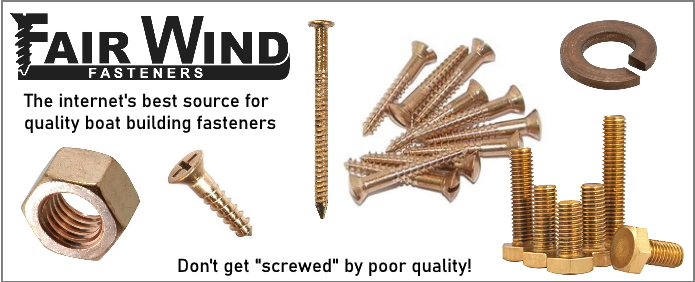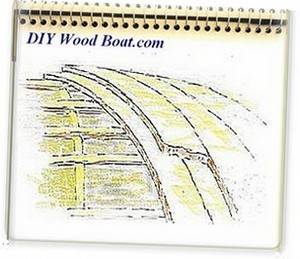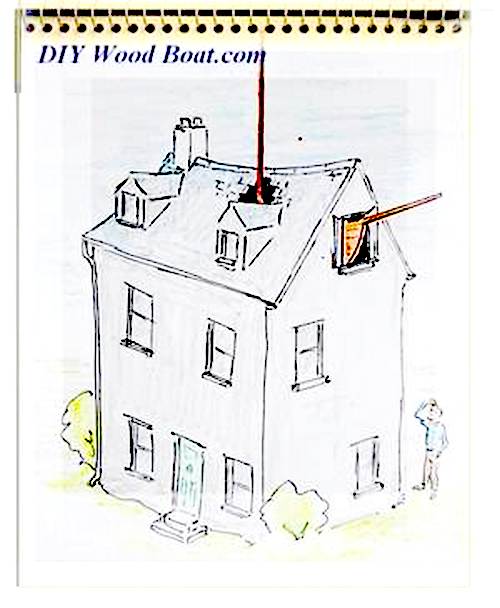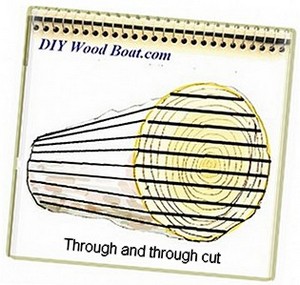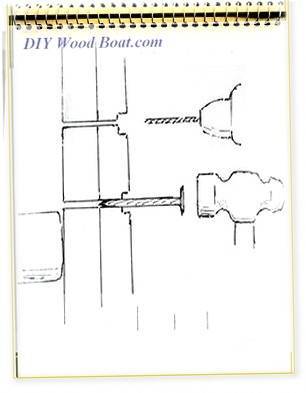Replacing / Repairing Wooden Boat Frames
The frames of a wooden boat should be considered as part of her backbone.
When doing any restoration or repairs, checking and overhauling the backbone should have priority over any other joinery work.
Apart from determining the shape of the hull, the framing carries much of the loading from the keel upwards through the planking as well as transverse loads, especially amidships, over engines bays, centreboards, and mast steps.
Most framing repairs are however, well within the capabilities of the average handyman.
Signs of Failure
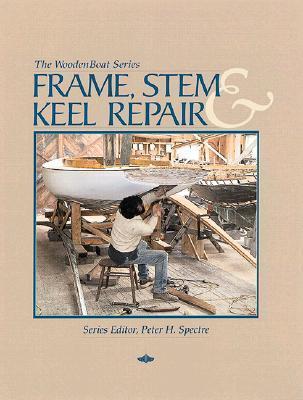
The most obvious signs of damage
will appear on the
outside of the hull.
- Hard spots or bulges in the planking.
- Open seams especially around the turn of the bilges.
- Any signs of sagging when viewed from end on.
However, not all damage
will be so obvious and
may be just awaiting one more knock to cause disaster.
And if repairs have been made previously any hard spots may have been faired off on the outside.
So, the real checks must
be made on the inside of
the hull.
Any hard spots which
have bee faired on the
outside will still show up on the inside.
Any previous sistered repairs deserve close inspection.
This is where you will need a torch, cracks will be hard to see in poor lighting.
And a mirror will be handy to see behind any fixtures and fittings.
Not even then will all cracks be obvious, they may be hidden under paint or behind stringers.
When I began restoring Mignonne it wasn’t until I stripped out all the furniture that I became aware of the number of damaged ribs.
However, you can concentrate on the more usual areas where damage occurs.
Check the bottom or heel of each for cracks and especially decay.
The heel carries the majority of the loading from the ballast through the floors and garboards up through the planking.
And don’t forget to check the floors themselves for damage.
There is no point replacing or repairing the frames if the floor timbers are in bad shape.
Behind the bilge stringer is a prime area for cracks this is often where the frame curvature is most severe.
And anywhere where the framing comes into contact with metal fittings such as chain plates.
If there are any gaps between the ribs and the planking this is most likely to be a sign of fastening failure.
Causes of failure.
There are many reasons why framing breaks the most common ones are.
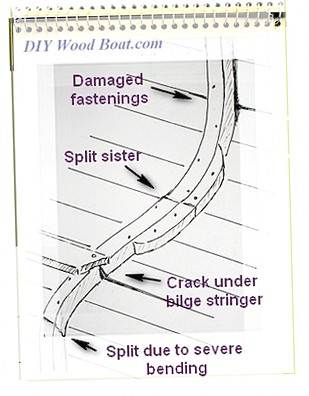 Frame Problems
Frame Problems- Poor design
- The scantlings not large enough for the loads.
- The severity of the bending,
- Fastenings too large or too close to edge,
- The fastenings not being staggered
- Decay especially from fresh water ingress and rusting iron.
- Over caulking especially on woods like mahogany which swell a lot.
- Over heating and bending when being steamed,
- Stress caused by collisions or grounding,
- The normal constant flexing of the hull
- The extra stress in areas such as engine beds, mast steps and chain plates.
Types of Failure.
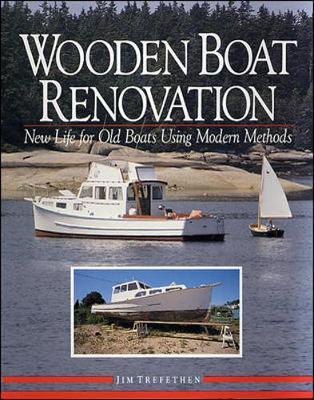
There are several types of
failure.
- Tensile cracks,
- Rot,
- Clean breaks,
- Splits,
- Fastening failure,
Clean breaks are usually associated with external damage.
Stress cracks are almost always found adjacent to the fastenings, especially those close to the edge of the frames.
Cracks can occur along the side of the ribs where they make contact with the planks.
Splits and rot in the heel or bottom of the frame will affect their ability to transfer loads from keel up resulting in open garboard seams.
Damage or corrosion to the heads of fastenings will prevent them holding the planks in place corrosion can also enlarge the holes weakening frame.
Replace or Repair?
A frame can be repaired by fastening a sister along side the damage.
If the condition of the rest of the boat is reasonable sister framing can be a reasonable option.
However it is never more than a holding strategy.
While it may be OK for lightly stressed frames such as in the ends those which carry high loads should be replaced
It is also difficult to tie sisters to the floor timbers, the deck and under stringers.
In a small, open boat it is just as easy to replace, as it is to sister.
In large boats, and cabin cruisers replacement can be more difficult especially where interior fittings and joinery work will have to be removed for access.
However, replacing the damaged ones with new, when done properly, is, from the structural point of view, always the best option.
Removing Old Frames.
Removing the old ribs from an old boat without damaging the planking can be difficult if they are stuck to the planking with layers of paint.
One method is to grind off the heads of the fastenings on the inside, then carefully pull the frame away form the planks.
Another method is to use a skilsaw/circular saw to chop them into short lengths, set the depth of cut so as not to damage the plank, and take care not to hit any fastenings.
Then carefully split the lengths along the line of the fastenings with a chisel.
Clean out caulking particularly where there is any deformation in plank curvature or where the seams are open so that the new frame will be able to draw the planks back into shape.
Sawn Frames.
The strongest most stable frames are sawn from suitably grown crooks.
Natural grown crook frames can be found with a bit of patience and searching in wood yards.
They can be made up from pieces/futtocks with butt joints or scarf joints.
However a butt jointed rib will only be as strong as the butt joint.
It is better if they are double sawn, glued and fastened with scarf joints
Steaming.
Steaming has successfully been used in many boat building yards for many years.
It is an effective way to produce curved timbers using a minimum of lumber.
However for the amateur builder or restorer it has quite a few disadvantages.
- Firstly the steaming process is dangerous, that steam is hot.
- The apparatus required, the steam box, the seam generator and all the piping is complicated.
- The temperature is fairly critical especially during the last part of the process.
- Over steaming will ruin the structure of the wood.
- Even normal steaming breaks the wood down chemically.
- The timber needs to be green, the kiln dried lumber normally found in wood yards these days is not suitable.
- If you steam one rib at a time you will have a long wait between each, if you steam a batch then they will all have to be put in place very quickly, before they cool or over steam if left in the steamer.
The wood could be just boiled rather
than steamed but
this again poses the problem of suitable apparatus.
I have heard of someone
using a hot air blower after
first oiling the wood, this might be useful for bending specific
areas.
You also need to bear in
mind that different woods vary
in their ease of bending when steamed.
Hardwoods such as elm, oak
and ash react well to steam
bending but many types of softwood are not suitable.
Here is an interesting idea using a wallpaper steamer.
The time needed in the steamer will depend on the thickness of the wood, about an hour for every inch or 2.5 cm.
Don’t forget the loves that wood is going to be hot.
affiliate linksLaminating.
 Sawn and Laminated Frames
Sawn and Laminated FramesLaminating, should I suppose, really be classed under sawn-frames.
This, in my humble opinion is one of the best methods of replacement.
As far as I can see there are only two disadvantages.
- As the wood strips will only bend in one direction, the frame may not follow the line of the originals and so run out at top and bottom, thus requiring extra holes to be drilled in the planking.
- They can delaminate if the gluing process is not perfect.
However these are outweighed by the advantages.
- They are strong.
- Veneers can be easily be fed behind stringers and beam clamps.
- No need for elaborate steam boxes.
- No need for skilled woodworking ability.
- They can be laminated in situ.
- Any straight grained timber can be used.
- The internal structure of the wood will not be damaged.
- Wood screws can be used as fasteners, this is not advisable with steam bent ribs as the internal wood structure will have been weakened.
They can be laminated on a jig after having taken a template from the hull.
Or laminated in situ using braces clamped to over head beams.
On Mignonne I used ¼ inch thick elm which bent easily into the fairly gentle curves of her hull.
They were then glued with resorcinol resin glue.
I held them in place with braces clamped to head beams as well as two or three through bolts.
Sistering.
Sister framing is a stop gap measure.
Sistering is the placing of a new section next to a crack in the existing frame.
It is a stabilising measure which will prevent the problem for getting any worse.
It is certainly much cheaper, quicker and easier than complete replacement and will cause less disturbance to the rest of the boat.
However, it should only be used on isolated cracks.
Sistering will require extra holes in the planking as well as adding extra weight.
And the repair will not be able to carry transverse loads as well as a full replacement.
Sistering can also put extra stresses on the adjacent fastenings.
Any sisters you do fit should be of equal or greater size to the original and should extend well beyond damaged area.
And besides that they just don’t look good.
If your boat needs any further restoration work such as plank replacement having sound frames should be the number one priority.
UHMW
The problem these days, especially for amateurs like us, is getting hold of decent timber.
Then there is all the bending beveling etc.
The last ribs I replaced were laminated, in situ but if I ever have to do it again I would be seriously looking at using UHMW polyethylene.
It goes against the grain (ha, ha) but take a look at the video below by Louis Sauzedde.
Ultra-high-molecular-weight polyethylene (UHMWPE, UHMW) is a subset of the thermoplastic polyethylene. Also known as high-modulus polyethylene, (HMPE).
affiliate links
Previous posts
See What Others Have Posted
Rib Seperation
I just purchased a 1960 pennyan 17 runabout with an outboard.
The boat has been sitting on a trailer with the interior removed,for about ten years. …
Replacing Ribs dispite Cement Bilge's....
Hello All!
I have a predicament, I'm repairing some broken ribs in my recently purchased 1940's Pitch pine on oak gaff cutter, long keel yacht.
…
What is the best wood to use for ribs
What is the best wood to use for ribs?
Cape Cutter 19, frame distance
Ok I’m new to boat building and I am far from having wood working experience.
That said I am making my first boat the design I’m working from is the …
